| | Introduction | Profile of generations in Alberta and Canada, 2011 | Major generational differences | Key learning | Source
.
Introduction
Consumers are shaped, not only by their unique experiences, but also by common life stages. These may include being a student, establishing a career, getting married and having a family. Beyond these commonalities, members of every generation are set apart from other generations by the particular social, economic, political and technological environment of their youth.
Generational differences in lifestyle and attitudes translate into distinct needs, preferences and expectations when it comes to food choices. Consumer interests and these differences have important implications to the agriculture and the agri-food industry. In this issue, we provide an overview of Canadian age demographics and highlight major differences of food habits and preferences among these generations.
An analysis of generations in Canada and Alberta show millennials and boomers are the largest groups. These two groups account for about 57 per cent of the total population in both Canada and Alberta. Compared to Canada, Alberta’s population is younger. Alberta has higher percentages of millennials and generation Z and a lower percentage of baby boomers and seniors.
The generation born after millennials is emerging as the next ‘big’ consumer group. It will be interesting to see how these groups have changed and evolved in the release of the 2016 census data in 2017.
Profile of Generations in Alberta and Canada, 2011
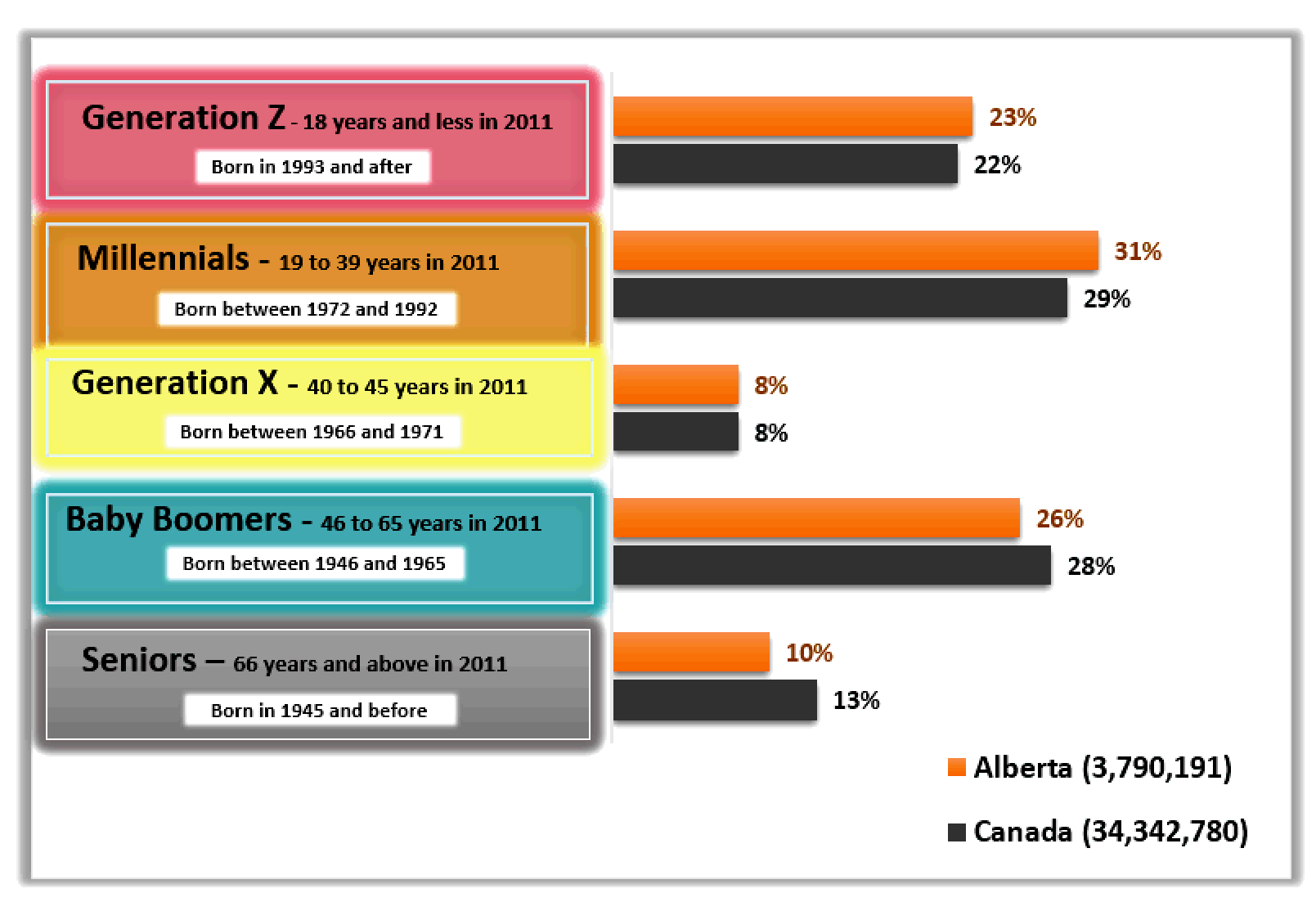
Source: Statistics Canada. 2011 Census
Major Generational Differences
Generational differences among seniors, baby boomers, Generation X, millennials and Generation Z are covered in this issue.
Different generations are shaped by the social, economic, political, technological and environmental factors they grew up in. The World War II and Great Depression were two major factors that affected seniors. Baby boomers’ life styles were influenced by the invention of television, the Cold War, feminism, space travel, youth culture and stay-at-home moms. The energy crisis of the 1970s, personal computing technology's first wave, the fall of Berlin Wall, music videos, and working mothers shaped generation X’s life styles.
The explosion of technology and media, multiculturalism and a variety of family structures influenced millennials and Generation Z. Different lifestyles and attitudes are reflected in food purchasing and eating behaviors as well.

According to the 2011 Census, about 13 per cent of Canadians are considered seniors. However, with the first of the baby boomer generation turning 65 years of age in 2011, seniors will account for an increasingly larger proportion of the Canadian population. This group is expected to grow to about 25 per cent by 2030.
Senior Canadians are a heterogeneous group. This heterogeneity is mainly defined by their health status, autonomy and socioeconomic support rather than the generation itself. Seniors can be categorized into three basic segments: active healthy seniors who want to maintain youth, seniors living independently and managing their health and those in assisted living situations. Each of these segments has specific nutritional requirements that should be considered when developing and marketing new and innovative food products.
Age-related biological or environmental factors such as reduced appetite, reduction in taste and smell acuity as well as problems with chewing and swallowing would indicate a need for appetizing products that appeal to the eye and have good mouth texture. For seniors with medical conditions and decreased mobility, specialized foods are required at the retail levels well as for institutions.
| Top health concerns of aging Canadians |
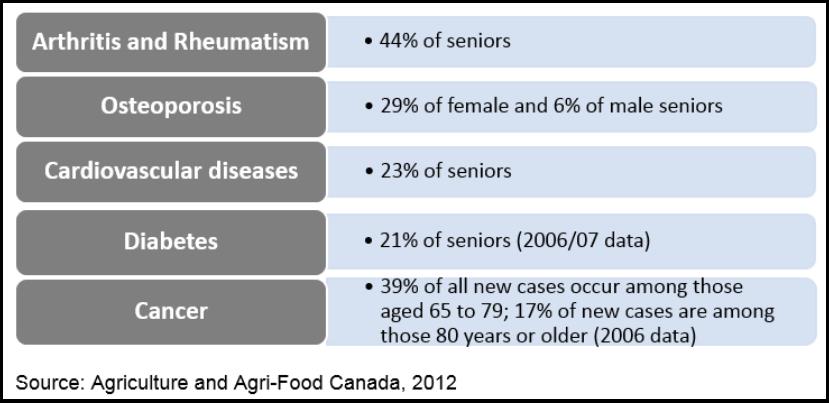
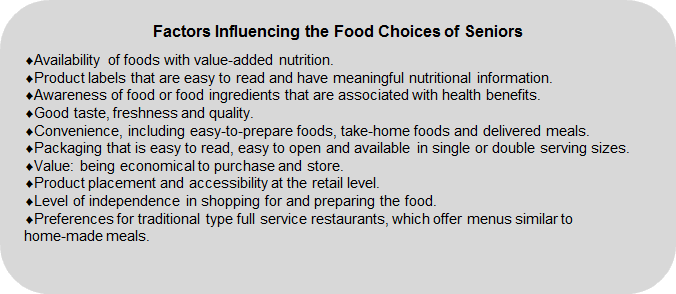

Boomers consisted of 28 per cent of the Canadian population in 2011. While this segment is a broad source of market demand, it is also the segment with the highest purchasing power. Baby boomers are different than their parents. Boomers have the most income and spend the most. They are more tech savvy and more marketing-friendly than previously thought.
Compared to previous generations, baby boomers grew up in a less agrarian world. Therefore, they are more likely than their parents to find work in an office environment, thus avoiding some of the most physically exhausting lines of work.
One of the biggest health concern among boomers is being overweight or in an obese condition. About 63 per cent of boomers are overweight or obese. This condition often leads to an increased chance of developing health issues such as; high blood pressure, diabetes and high cholesterol. Although this generation is less healthy than the previous generation, medical advancements and early detection of disease conditions have helped to increase their wellness and longevity. Boomers are staying longer in the workforce and often plan to work longer as they think it keeps them more active. Their expectation to live longer gives rise to other behaviors such as being physically active, more focused on healthy eating and weight management. In addition, baby boomers are in a major state of change with many moving from family households to empty nest households. All these factors are affecting their food consumption patterns.
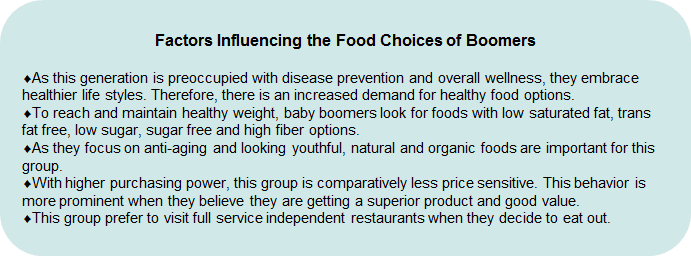

Generation X is a smaller group in Alberta. This group reached their adulthood during difficult economic times. They have experienced rising divorce rates and violence. They have taken greater responsibility for raising themselves and tend to be less traditional than any other generations. This group is highly educated even though they tend to be pessimistic, sceptical and disillusioned with many things. One of the main characteristics about the lifestyle and attitude of generation X includes a commitment to balancing family life and work.
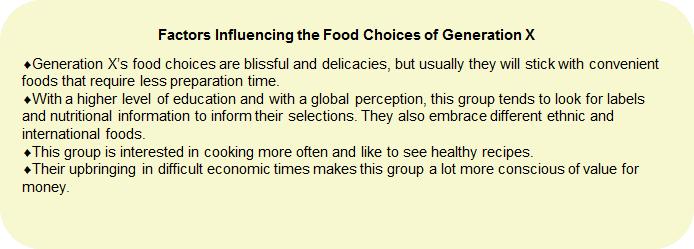

Millennials are children of the original baby boomers. They grew up in a time of immense and fast-paced change including the following: virtually full employment opportunities for women, dual-income households as the standard, a wide array of family types, respect for ethnic and cultural diversity including a heightened social awareness, and computers in the home and schools.
These individuals are well grounded and wise for their age. They were born into a technological society with global boundaries becoming more transparent.
They have a greater need for peer acceptance, connecting with their peers, fitting in and social networking. Millennial individuals are open-minded, optimistic, goal oriented, and highly motivated toward their perception of success.
Eight key values have been described for Millennials including choice, customization, scrutiny, integrity, collaboration, speed, entertainment and innovation. Their ability or willingness to multitask helps them to be successful.
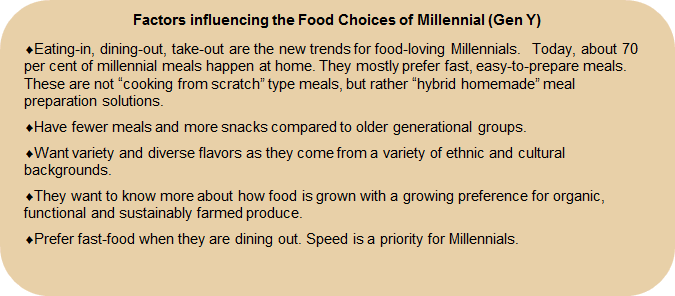

Generation Z was born after 1993 and they were less than 18 years old in 2011. They are accustomed to high-tech and multiple media sources with information bombarding them from all sides. They have never lived without the internet. Generation Z values authenticity and “realness”. Peer acceptance is very important to Generation Z, they need to belong. Their self-concept is partially determined by the group to which they belong. They are a global and diverse generation who come from a wider mix of backgrounds with different experiences and ideas. Generation Z values security more than ever. They are ready to be on mission, confident and very optimistic. They quite possibly are the most imaginative generation. The younger members of Generation Z might not have their own disposable income, but they have a strong influence over family purchasing decisions.
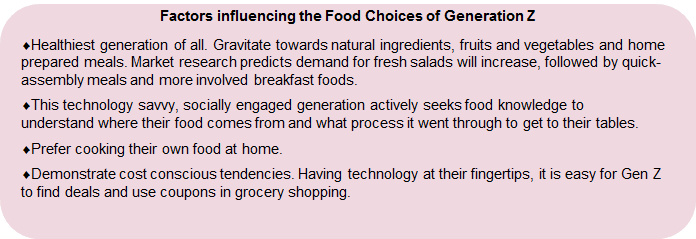
Key Learning
- It is important to recognize that concerns for health and wellness are present in all generational groups, but for different reasons.
- Understanding generational differences and food habits is important for agri-food producers, processors and marketers to be innovative as well as to tailor marketing and product messaging towards the generation that they are trying to reach.
Source
|
|